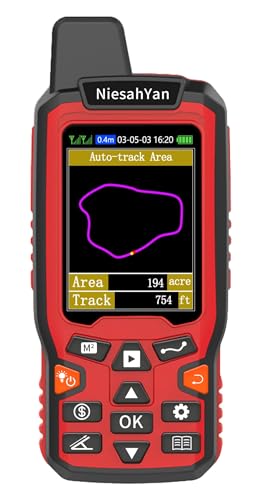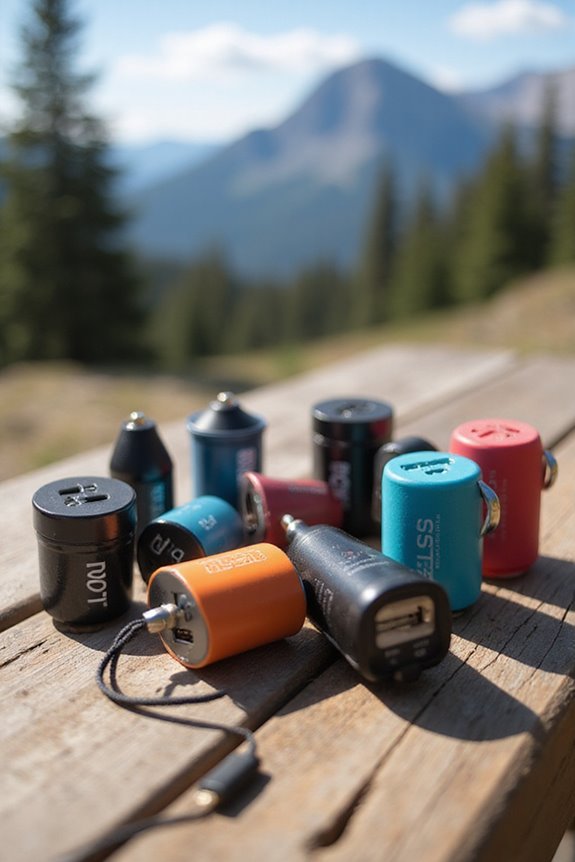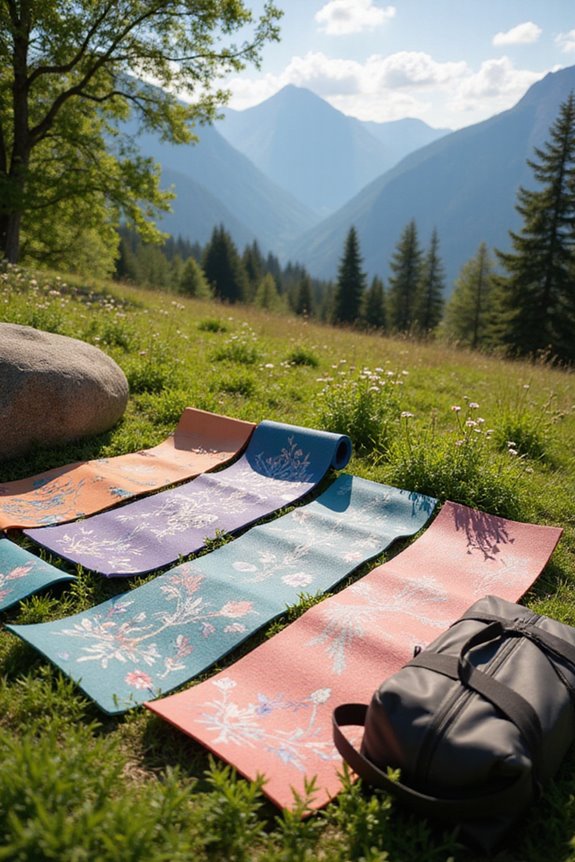As an Amazon Associate, we earn from qualifying purchases. Some links may be affiliate links at no extra cost to you. Although our opinions are based on curated research, we haven't used these products. Articles generated with AI.
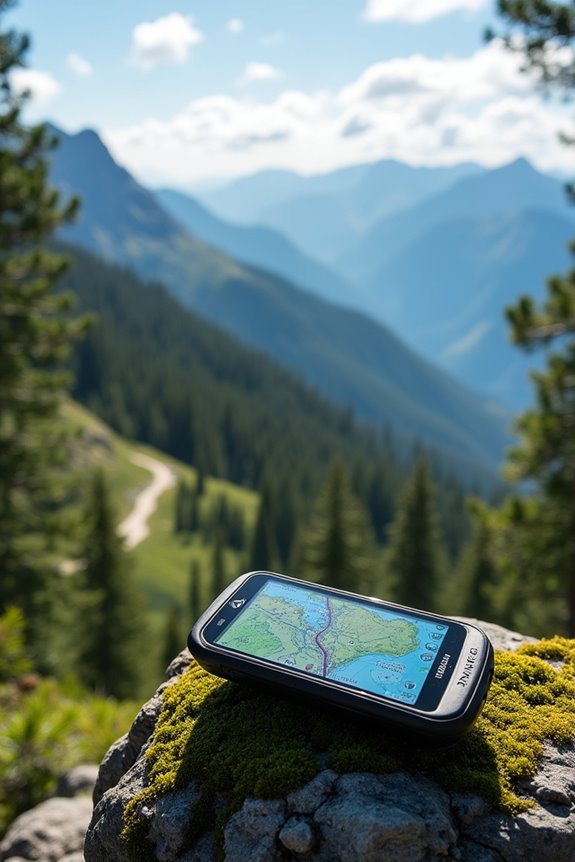
8 Best GPS Devices for Hiking: Navigate the Great Outdoors With Confidence
When it comes to choosing the best GPS devices for your hiking adventures, you’ve got plenty of options. The Spot Gen 4 is perfect for remote areas with its SOS feature, while the Garmin GPSMAP 67i offers rugged durability and inReach technology for two-way messaging. Need something lightweight? The Garmin eTrex SE is easy to carry and water-resistant. Whichever you choose, these devices enhance your outdoor experience, helping you navigate confidently. Stick with us to explore more options!
Key Takeaways
- Explore reliable options like Garmin GPSMAP 67i and inReach Mini 2 for rugged, long-lasting communication while hiking in remote areas.
- Look for devices with multi-GNSS support for enhanced navigation accuracy and precision under 5 feet in varied terrains.
- Prioritize battery life; devices should ideally last over 20 hours in navigation mode for extended multi-day adventures.
- Ensure weather resistance with a minimum IPX7 rating to protect your GPS from rain and harsh outdoor conditions.
- Consider user-friendly interfaces with clear displays and easy-to-operate buttons, essential for navigating rugged environments.
Spot Gen 4 Satellite GPS Messenger for Outdoor Activities
Sale
Spot Gen 4 Satellite GPS Messenger | Handheld Portable GPS Messenger for Hiking, Camping, Outdoor...
- MEANT FOR ADVENTURE: Spot Gen4 provides critical, life-saving line of communication when you travel beyond cell towers; Let family know you're ok or push the SOS button...
- NO CELL PHONE OR SERVICE-NO PROBLEM: With the Tracking feature Gen4 can transmit location updates when you are moving and when you stop; Keep one in your child's backpack...
- GLOBALSTAR SATELLITE & SPOT products use GPS to determine location and transmit GPS coordinates to others; SPOT users can notify friends, family or emergency rescue their...
If you’re an avid hiker or outdoor enthusiast who often ventures into remote areas, the Spot Gen4 Satellite GPS Messenger might just be your new best friend. This portable device, powered by the Globalstar Satellite Network, keeps you connected even when there’s no cell service.
Imagine letting family know you’re safe with the push of a button or activating the SOS feature in a pinch—pretty reassuring, right? Plus, with its tracking capability, you can share your exact location with loved ones, giving them peace of mind. It’s the perfect companion for solo adventures or family hikes!
Best For: Outdoor enthusiasts, hikers, and campers who require reliable communication in remote areas without cell coverage.
Pros:
- Critical Safety Features: SOS button allows for immediate assistance in emergencies by sending GPS coordinates to responders.
- Global Coverage: Utilizes GPS technology to ensure communication and tracking capabilities in even the most remote locations.
- User-Friendly Tracking: Easily share your exact location with family and friends, enhancing safety during solo or group adventures.
Cons:
- Subscription Required: Users must choose and activate a service plan for the device to function, adding ongoing costs.
- Battery Dependency: Relies on batteries, which may need to be monitored or replaced during extended trips.
- Limited Functionality: Primarily focused on safety communication rather than providing navigational tools like maps or detailed directions.
ZL180 Handheld GPS for Surveying
ZL180 Handheld GPS for Surveying, High Precision Rugged Land Surveying Equipment for Ranches,...
- HIGH PRECISION ACCURACY: 2 high sensitivity satellites global GPS + GLONASS coverage for reliable surveying around the world, support for fast positioning and a reliable...
- LARGE LCD: Our Product has a 2.4 inch FSTN panel and equipped with LCD backlight display, the measurement results can be displayed on the screen directly, convenient for...
- RUGGED DESIGN: Our Product has a weight of approximately 180g/6.3oz and is compact, making it easy to carry. Adopts humanized groove design, easy to hold and not easy to...
The ZL180 Handheld GPS is an excellent choice for those seeking accurate surveying capabilities in diverse outdoor settings. With its compact dimensions of 5.5 x 2.3 x 1.1 inches and lightweight design at just 6.3 ounces, this rugged GPS device makes surveying a breeze. You’ll appreciate its high accuracy, powered by two precision satellites (GPS + GLONASS), ensuring minimal errors when measuring areas and distances.
The user-friendly buttons and bright display let you easily operate it, even under glaring sunlight. While it might take a little practice to master, this GPS is a game-changer for measuring your backyard or property boundaries.
Best For: The ZL180 Handheld GPS is best for surveyors and outdoor enthusiasts needing a reliable and precise measuring tool for larger land areas.
Pros:
- High accuracy with GPS + GLONASS satellite support ensures minimal measurement errors.
- Rugged and compact design makes it lightweight and easy to handle in various outdoor environments.
- User-friendly interface with bright display allows for easy operation, even in direct sunlight.
Cons:
- May require a learning curve due to dense manual and initial trial and error with operations.
- Not suitable for short distances or small tracts, limiting its use in certain situations.
- Accuracy can vary based on satellite signal strength and measurement range.
Garmin GPSMAP 67i Rugged Hiking GPS with inReach Technology
Garmin GPSMAP 67i Rugged Hiking GPS Premium Handheld inReach Satellite Technology, Two-Way...
- inReach Satellite Communication: Stay connected anywhere with two-way messaging, interactive SOS alerts, and location sharing and tracking via the global Iridium...
- Multi-Band GNSS Support: Access multiple global navigation satellite systems (GPS, Galileo, QZSS) for improved position accuracy, especially in challenging terrain or...
- Satellite Imagery and Preloaded Topo Maps: Large 3” sunlight-readable color display for easy viewing Screen, Download high-resolution maps via Wi-Fi technology and...
For outdoor enthusiasts who crave connectivity even in the most remote locations, the Garmin GPSMAP 67i with inReach technology stands out. This rugged handheld GPS not only navigates effortlessly through nature but also keeps you connected via the Iridium satellite network. With two-way messaging and an SOS alert system, you can share your location or call for help—just don’t forget the subscription!
Built to military standards, the 67i takes a beating while remaining reliable. Plus, its battery lasts up to 165 hours. Whether you’re hiking, camping, or exploring, this device is your ultimate adventure partner—just don’t lose it in the wild!
Best For: Outdoor enthusiasts and adventurers who require reliable navigation and communication in remote areas.
Pros:
- Exceptional battery life of up to 165 hours, perfect for extended outdoor trips.
- Built to military standards for durability against harsh environmental conditions.
- Active two-way messaging and SOS capabilities provide safety and peace of mind while exploring.
Cons:
- Requires an expensive subscription to access key features like SOS and two-way messaging.
- Some users may find the interface complicated compared to previous models, posing a learning curve.
- Bulkiness compared to smaller GPS devices may impact portability for some users.
Motorola Defy Satellite Link – Rugged Handheld GPS Communicator
Motorola Defy Satellite Link - Rugged Handheld GPS Communicator, Two-Way Global SMS Text Messenger,...
- Service plans required - as low as $4.99 per month for SOS satellite assist
- Provides advanced 2-way satellite-enabled messaging. Compatible with iOS 14 and Android 10 and later smartphones
- Stay in contact wherever you go—reliable satellite coverage keeps you firmly on the grid even if you're off the edge of the map, ensuring you're in touch with those who...
Experience the great outdoors without losing touch with the world, thanks to the Motorola Defy Satellite Link. This rugged handheld GPS communicator doubles as a two-way global SMS text messenger, letting you connect even in the remotest areas. With advanced satellite-enabled messaging, you can check in with loved ones at the push of a button, sharing your coordinates to ease their minds.
If trouble strikes, the SOS assist feature guarantees you can trigger help, no service needed. With service plans starting as low as $4.99, you’ll stay safe and connected, no matter where your adventures take you!
Best For: Outdoor enthusiasts and adventurers who need a reliable way to communicate in remote locations.
Pros:
- Offers advanced two-way satellite-enabled messaging, ensuring connectivity in areas without cell service.
- SOS assist feature allows for emergency help to be triggered without any service, providing an added layer of safety.
- Affordable service plans starting at $4.99 per month make it accessible for users seeking peace of mind during their outdoor activities.
Cons:
- Requires compatible smartphones, limiting use to those with iOS 14 or Android 10 and later.
- The satellite communication may have delays compared to typical mobile messaging services.
- Potentially higher costs for extensive messaging beyond the basic service plan features, depending on usage.
Garmin eTrex SE GPS Handheld Navigator
Sale
Garmin eTrex® SE GPS Handheld Navigator, Extra Battery Life, Wireless Connectivity, Multi-GNSS...
- The 2.2” high-resolution display is easy to read, even in bright sunlight
- Get long battery life of up to 168 hours in standard mode and up to 1,800 hours in expedition mode with 2 field-replaceable AA batteries (not included)
- Pair with the Garmin Explore app on your compatible smartphone for wireless software updates, trip planning, Active Weather, smart notifications and additional mapping
Looking for a reliable companion on your hiking adventures? The Garmin eTrex SE is your perfect sidekick. Weighing just 5.5 ounces, it’s light enough to forget you’re carrying it. The 2.2” high-resolution screen works wonders in bright sunlight, ensuring you can read it even on that sunny summit.
With a battery life of up to 168 hours, or an impressive 1,800 hours in expedition mode, you won’t run out of juice mid-hike. Plus, its IPX7 water resistance means it won’t freak out in the rain. So, get ready to explore!
Best For: Outdoor enthusiasts and hikers looking for a lightweight, durable GPS navigator with extended battery life and high readability in bright conditions.
Pros:
- Long battery life of up to 1,800 hours in expedition mode, ideal for extended trips.
- Lightweight design at 5.5 ounces, making it easy to carry on hikes.
- High-resolution screen readable in bright sunlight, enhancing visibility outdoors.
Cons:
- Users may experience a learning curve with the classic Garmin menu interface.
- Lack of elevation history functionality may be a drawback for some hikers.
- Some reports of occasional device instability and clunky menu navigation.
Garmin inReach® Messenger Handheld Satellite Communicator
Sale
Garmin inReach® Messenger Handheld Satellite Communicator, Global Two-Way Messaging
- Small, rugged, lightweight satellite communicator enables two-way text messaging even in areas with no cell coverage (Active satellite subscription required. Some...
- Send two-way messages globally; easily text back and forth directly with friends via the Garmin Messenger app, even when you’re out of cellular coverage. (Active...
- Group messaging via the Garmin Messenger smartphone app lets you share your adventures with multiple contacts simultaneously — and have group text chats with friends...
Adventure-seekers and hikers craving peace of mind can find a reliable companion in the Garmin inReach® Messenger. This rugged, lightweight satellite communicator keeps you connected, even in the most remote areas. With global two-way messaging, you can text friends through the Garmin Messenger app, regardless of cellular coverage. Plus, pre-set messages help you check in without counting against text limits—convenient, right?
The battery life can last up to 28 days in tracking mode, although heavy messaging might reduce it. Should you need to power up another device, it’s got your back! Just remember, subscriptions can be suspended during downtime.
Best For: Adventure-seekers and hikers looking for a reliable communication tool in remote areas.
Pros:
- Reliable connectivity through global two-way messaging via satellite, even without cellular coverage.
- Long battery life, lasting up to 28 days in tracking mode, suitable for extended outdoor adventures.
- Flexible subscription options that allow users to suspend plans during periods of non-use.
Cons:
- Battery life may vary significantly under heavy messaging use, often averaging 2-3 days.
- Some users report issues with the Garmin Messenger app functionality, which can affect user experience.
- Requires an active satellite subscription, which may involve additional costs and potential regulations in certain areas.
A6 Handheld GPS Navigator for Hiking
A6 Handheld GPS for Hiking, Multi-GNSS Support, Lightweight Rugged GPS Navigator,Waterproof GPS...
- HIGH ACCURACY:Access 4 global navigation satellite systems (GPS+GLONASS+BEIDOU+QZSS) for improved position accuracy, especially in challenging terrain or areas with weak...
- SCREEN: 2.4 inch sunlight-readable color display for easy viewing, can see the navigation interface clearly even at night,also equipped with button-operated and non-slip...
- 4 WAYPOINT FUNCTION: Save current GPS coordinates, enter known coordinates, and navigate to the coordinates, delete coordinates,can save 1000 waypoints
For those who crave reliability in the great outdoors, the A6 Handheld GPS Navigator stands out with its robust multi-GNSS support. This lightweight and rugged device is waterproof (IP65 rated), perfect for unexpected rain. With a 2.4-inch sunlight-readable color display, you’ll have no trouble viewing your path.
Its incredible accuracy, with a position accuracy of less than 5 feet, lets you navigate confidently. Save up to 1,000 waypoints, track your routes, and easily find your way back. Plus, it boasts a long battery life of up to 20 hours. A bit clunky in design, but hey, it gets the job done!
Best For: Outdoor enthusiasts seeking a reliable, accurate, and waterproof GPS navigator for hiking adventures.
Pros:
- High accuracy with position precision of less than 5 feet, ensuring confident navigation.
- Lightweight, rugged, and waterproof design (IP65 rated) suitable for various outdoor conditions.
- Long battery life of up to 20 hours in navigation mode, with multiple charging options available.
Cons:
- User interface can be clumsy with a steep learning curve, making it less intuitive for some users.
- Lacks options for different coordinate types, which may limit functionality for advanced users.
- Some users consider it pricey, especially given its basic features compared to competitors.
ZOLEO Satellite Communicator – Two-Way Global SMS Text Messenger & Email
Sale
ZOLEO Satellite Communicator – Two-Way Global SMS Text Messenger & Email, Emergency SOS Alerting,...
- Global satellite messaging: Stay connected beyond cell coverage, use ZOLEO with your smartphone to transmit text messages and e-mails over the Iridium satellite network,...
- Emergency SOS: Send an SOS alert with your GPS location to 24/7 emergency monitoring center if something goes wrong, or access Medical Assist for non-emergency help
- Optional Travel Risk Management Coverage: Feel more secure wherever you go with a Field Rescue Membership from Global Rescue. Affordably priced, this travel risk...
When you’re out hiking in the wilderness, communication might not be your first thought, but it sure can save your day—or your life! The ZOLEO Satellite Communicator keeps you connected globally via the Iridium network, cellular, or even Wi-Fi. You can send texts and emails directly from your smartphone, so staying in contact with family or friends is easy, even off the grid.
Features:
- Emergency SOS: Alerts a 24/7 monitoring center with your GPS location.
- Check-Ins: Unlimited check-ins let folks know you’re okay.
- Durability: Rugged design with an impressive 200-hour battery.
With ZOLEO, you’ve got peace of mind wherever your trail takes you!
Best For: Adventurers and outdoor enthusiasts who require reliable communication in remote areas.
Pros:
- Global connectivity via Iridium network, cellular, or Wi-Fi, ensuring you can communicate from almost anywhere.
- Emergency SOS feature provides peace of mind by connecting you to a 24/7 monitoring center with your GPS location.
- Durable design with an IP68 rating and over 200 hours of battery life, making it ideal for rugged outdoor conditions.
Cons:
- Requires a service plan for full functionality, which may incur additional costs.
- Limited messaging options compared to traditional cellular networks, primarily SMS and email.
- Dependent on satellite visibility, meaning performance may vary in heavily wooded or mountainous areas.
Factors to Consider When Choosing Gps Device Hiking
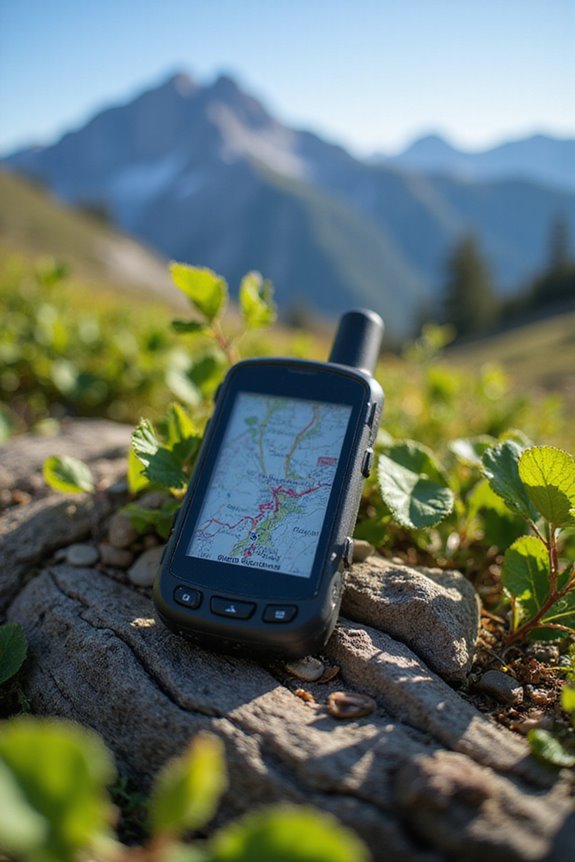
When you’re picking a GPS device for hiking, think about a few key factors that can make or break your outdoor adventures. Battery life, navigation accuracy, and durability are essential, especially if you’re venturing into the wild for days on end. Plus, ease of use and communication capabilities can turn a stressful situation into a smooth-sailing hike, so you’ll want to keep those in mind too!
Battery Life Considerations
Choosing a GPS device for hiking isn’t just about the latest features—it’s also about how long that device can keep you from wandering off the grid. Battery life is critical, especially on those multi-day adventures. Look for a device with over 20 hours of battery life in navigation mode; that’s your safety net! Some models even offer expedition modes, stretching usage to an incredible 1,800 hours in low-power conditions. Consider options with rechargeable lithium-ion batteries and multiple charging methods—solar panels, power banks, or car chargers can save the day. Features like adjustable screen brightness and power-saving modes are lifesavers too. Remember, a reliable GPS means you’re less likely to become a “Where’s Waldo?” on your hike!
Navigation Accuracy and Features
Steering through the great outdoors requires more than just a map and a dream; it demands precision to keep you on track, especially when that dream takes you off the beaten path. When choosing a GPS device, look for ones supporting multi-GNSS—GPS, GLONASS, Galileo, and BeiDou. This enhances accuracy, particularly in tricky terrain.
Aim for devices boasting an accuracy rating of less than 5 feet, vital for tracking your waypoints. Features like digital compasses, altimeters, and barometers are essential—providing insights on elevation and weather. Plus, storing up to 1,000 waypoints makes planning routes a breeze. Finally, keep an eye on battery life—opt for models lasting up to 1800 hours in expedition mode for those epic adventures!
Durability for Outdoor Use
While you’re out exploring nature, you want a GPS device that can keep up with your adventures, and that means durability is a must. Look for rugged designs that meet military standards like MIL-STD-810—this guarantees your device can handle thermal, shock, and water exposure. An IP rating of IPX7 or IP68 shows resistance to water and dust, perfect for unpredictable weather.
You’ll also want something lightweight, as every ounce counts on a hike, and a long battery life—ideally over 20 hours—to keep you fueled through multi-day treks. A non-slip, easy-to-grip design is key, reducing the chances of a heart-stopping slip when you’re maneuvering tricky terrains.
Communication Capabilities
In the great outdoors, staying connected can be as essential as having the right compass. Many hiking GPS devices now boast satellite communication features, letting you send and receive messages even where cell service dares not tread. With two-way messaging, you can check in with friends or contact emergency services when you’re off the beaten path.
Look for devices that include SOS functionality, allowing you to send distress signals alongside your GPS coordinates—talk about peace of mind! Just remember, subscription plans might be necessary for advanced features like global messaging. Plus, many devices sync seamlessly with smartphone apps, offering real-time updates and group chats for that extra layer of safety. So, gear up and stay connected!
User Interface Ease
How easy is it to navigate your GPS device when you’re on the trails? A user-friendly interface is essential. Look for clear menu navigation that lets you access functions without excess scrolling. For rugged hikes, button-operated systems offer better usability than touchscreens, especially when it’s wet or cold.
A bright, high-resolution display that’s easy to read in sunlight is a game-changer. Plus, concise user manuals help reduce the learning curve for beginners. Also, features like one-touch SOS buttons or preset messages simplify emergency communication, ensuring you’re prepared for anything.
Ultimately, a good GPS device should feel like a trusty hiking buddy—not a complicated puzzle!
Frequently Asked Questions
How Accurate Are GPS Devices for Hiking in Dense Forests?
When you hike in dense forests, GPS accuracy can drop considerably. Thick foliage and steep terrain block signals, causing delays or even complete loss of tracking. On average, you might see an accuracy of about 20-30 feet, which isn’t ideal. To improve your chances, choose a GPS with enhanced satellite reception, like multi-band devices or one specifically designed for rugged environments. Trust me, having reliable navigation is key to enjoying your adventure!
Can I Use GPS Devices Offline?
Can you use GPS devices offline? Absolutely! In fact, studies show that about 70% of hikers prefer using offline maps while finding their way. Offline capabilities let you download maps in advance, so you won’t lose your way when cell signals vanish among tall trees. Make certain your device has enough storage, and check if your GPS app supports offline features. It’s like having a trusty buddy, guiding you through the wild—no Wi-Fi required!
Do GPS Devices Require Regular Software Updates?
Just like your smartphone, GPS devices often require regular software updates. These updates fix bugs, enhance features, and improve accuracy. So, staying up-to-date helps you avoid that awkward moment of getting lost. Check for updates every few months, or set your device to auto-update if possible. It’s a small effort for big benefits—plus, who doesn’t love a fresh new feature?
What Is the Battery Life of Typical Hiking GPS Devices?
Ah, the good ol’ days when maps were just sheets of paper! Nowadays, a typical hiking GPS device can last anywhere from 12 to 30 hours on a single charge. Factors like screen brightness and usage patterns affect this. You might wanna carry a power bank for longer trips, just in case. Remember, keeping your GPS charged means you’re less likely to get lost—unless you forget to switch it on! Happy hiking!
Are There GPS Devices Specifically for Night Hiking?
Night hiking requires specific GPS devices that feature bright displays and backlighting. These gadgets not only guide you safely but also often include night mode settings to save battery life. Look for models with strong GPS signal reception, water resistance, and long battery life. Some even come with built-in flashlights—handy, right? So, grab a reliable device, and explore the trails under the stars!


